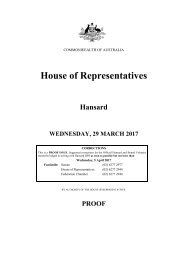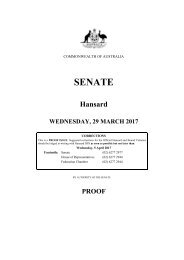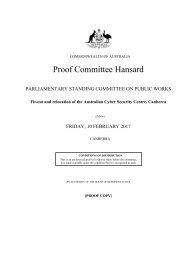SENATE
2e7N9wg
2e7N9wg
Create successful ePaper yourself
Turn your PDF publications into a flip-book with our unique Google optimized e-Paper software.
80 <strong>SENATE</strong> Thursday, 13 October 2016<br />
That brings me back again to the Defence Industry Policy Statement. If we accept the fact that air combat<br />
capability has a fundamental input to it, which is design engineering, then rather than looking at this program in<br />
isolation and looking at other programs—for example, something like the replacement for the training aircraft, the<br />
PC-9, in isolation—Defence has the opportunity, in fact the obligation, to look at that fundamental input to<br />
capability from a programmatic perspective. It should say, 'If we do not have enough places within the Joint Strike<br />
Fighter program to provide this training and development of competence for our young engineers then there is no<br />
logical reason, in terms of combat capability, with something like the PC-9 replacement for us not to hold a<br />
systems program office or do that engineering effort.' The rationalist approach to procuring that aircraft would be:<br />
let the OEM or another contractor do it by power by the hour for the aircraft, rather than doing it from an<br />
Australian sovereign perspective.<br />
But if we take the programmatic perspective, perhaps this is actually the lowest cost and most effective way to<br />
provide training opportunities for young engineers, who can develop an understanding of structures, power plants,<br />
engines, airframes, avionics and systems which they can then transfer into our combat capability such as the Joint<br />
Strike Fighter. That is the kind of opportunity that the Defence Industry Policy Statement provides, and I would<br />
certainly encourage Defence, as they look to making sure that we have the sovereign ability to operate this aircraft<br />
into the future, to take the opportunities to grow that workforce.<br />
My final comments are on the test and evaluation for this platform. My background is as an experimental test<br />
pilot in the military and I am aware that many people fall victim to the conspiracy of optimism. If there were one<br />
program in recent military aviation history that has had many people fall victim to a conspiracy of optimism it<br />
would be the Joint Strike Fighter program. Too much reliance has been placed on modelling, computer<br />
simulations, glossy brochures, marketing programs and unrealistic expectations and not enough focus has been<br />
placed on engagement in test and evaluation. I am pleased to see that there has been an increased focus on test and<br />
evaluation but I maintain the position, which I have put to Defence on many occasions, that Australia needs to<br />
invest more in the people we have engaged, not only in operational test and evaluation as the aircraft starts to be<br />
fielded but in making sure we have engineers and aircrew who are involved in the development and certification<br />
flight test activities. That is where we will develop the necessary deep understanding of any flaws, failures,<br />
weaknesses or strengths in the system. We can then adapt that understanding to our doctrine, procedures and<br />
tactics so that we can exploit the capabilities and compensate for any deficiencies in the system to maximum<br />
effect.<br />
The US Office of the DOT&E has highlighted a number of areas where there are ongoing concerns with the<br />
rate of progress through the T&E program. When I hear people talking about thinning out the number of test<br />
points in order to meet schedule, my background means I become nervous about the quality of the final clearances<br />
that are achieved. Again, I would encourage Defence to make strategic and investments into test and evaluation so<br />
that we are not just a receiver of what another country wishes to give us but active participants gaining<br />
information and access to raw data so that we can make our own analysis of what it is telling us about the<br />
capabilities of the platform.<br />
I commend the report to the Senate. The program is something we should continue with. It is, for the short to<br />
medium term, the most likely aircraft to meet our air combat capability needs. But I would make those three<br />
points again: we should expect to need a multiplatform fleet into the future; we should expect that the threats in<br />
our region and beyond will evolve and that the core characteristic of this platform may no longer, in the medium<br />
to long term, be the bulwark that it currently is advertised to be against emerging threats; and that we need to use<br />
the opportunities presented by the Defence Industry Policy Statement to develop sovereign capability, both in our<br />
industry and among our uniformed and civilian defence personnel, in particular in the design support and<br />
engineering network, to assure the continuing airworthiness and combat capability of this platform into the future.<br />
I seek leave to continue my remarks later.<br />
Leave granted.<br />
FIRST SPEECH<br />
The PRESIDENT (16:00): Pursuant to order, I now call Senator Griff to make his first speech and ask that<br />
honourable senators observe the usual courtesies.<br />
Senator GRIFF (South Australia) (16:00): Thank you, Mr President, and thank you to all in this chamber, to<br />
my colleagues, to the Clerk and her office, and of course to the attendants for the kind welcome and assistance<br />
given to me so far. It is an honour to be here and to give my first speech as South Australian senator 101 since<br />
Federation, which, given Senate school and the steep learning curve I have been on, is a most appropriate number.<br />
That I am able to stand here today in this role in this place was never certain. That is why I would like to begin<br />
this speech by paying respect to my mother, Vilma, who as a 30-year-old found herself alone with a 2½-year-old<br />
CHAMBER















